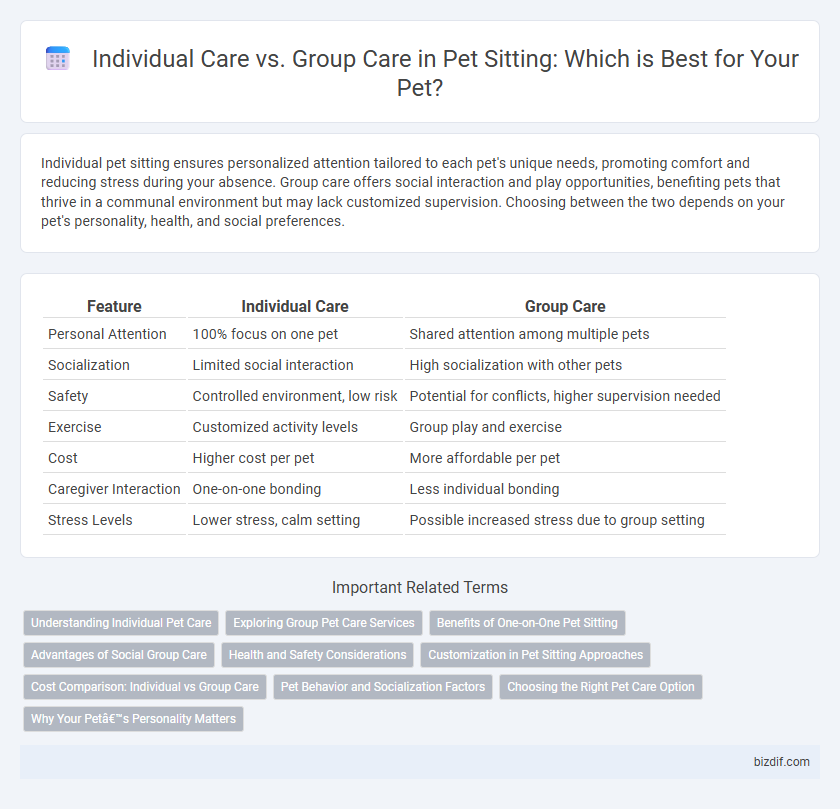Individual pet sitting ensures personalized attention tailored to each pet's unique needs, promoting comfort and reducing stress during your absence. Group care offers social interaction and play opportunities, benefiting pets that thrive in a communal environment but may lack customized supervision. Choosing between the two depends on your pet's personality, health, and social preferences.
Table of Comparison
| Feature | Individual Care | Group Care |
|---|---|---|
| Personal Attention | 100% focus on one pet | Shared attention among multiple pets |
| Socialization | Limited social interaction | High socialization with other pets |
| Safety | Controlled environment, low risk | Potential for conflicts, higher supervision needed |
| Exercise | Customized activity levels | Group play and exercise |
| Cost | Higher cost per pet | More affordable per pet |
| Caregiver Interaction | One-on-one bonding | Less individual bonding |
| Stress Levels | Lower stress, calm setting | Possible increased stress due to group setting |
Understanding Individual Pet Care
Individual pet care provides personalized attention tailored to each animal's specific needs, temperament, and health conditions, ensuring optimal well-being and comfort. This approach allows pet sitters to monitor behavior changes and administer customized feeding, exercise, and medication schedules. Prioritizing individual care enhances stress reduction and strengthens the bond between the sitter and the pet, leading to better overall outcomes compared to group care settings.
Exploring Group Pet Care Services
Group pet care services offer socialization opportunities that individual care often lacks, promoting healthy interaction among pets and reducing anxiety. Professional group settings are designed to supervise multiple animals simultaneously, ensuring safety while providing structured activities tailored to various energy levels and breeds. These services can be more cost-effective and beneficial for pets that thrive in dynamic environments, making group care a viable alternative to one-on-one pet sitting.
Benefits of One-on-One Pet Sitting
One-on-one pet sitting provides personalized attention tailored to a pet's specific needs, ensuring accurate medication administration and customized feeding schedules. This individualized approach reduces stress and anxiety in pets by maintaining their familiar environment and routine, promoting better overall health and behavior. Individual care also allows for immediate response to any changes in a pet's condition, enhancing safety and well-being.
Advantages of Social Group Care
Social group care offers pets consistent companionship, preventing loneliness and promoting natural social behaviors crucial for mental health. Interaction with other animals stimulates cognitive development and reduces anxiety, making group settings ideal for socially inclined pets. Professional pet sitters in group care environments monitor dynamics closely, ensuring safety while delivering enriched social experiences that enhance overall well-being.
Health and Safety Considerations
Individual care in pet sitting minimizes the risk of disease transmission and allows for tailored health monitoring, ensuring pets with specific medical needs receive personalized attention. Group care can increase socialization but poses higher risks of contagious illness spread and injury due to interactions among multiple animals. Ensuring stringent hygiene practices, vaccination verification, and close observation are critical in both settings to maintain optimal health and safety standards.
Customization in Pet Sitting Approaches
Individual care in pet sitting offers personalized attention tailored to a pet's specific needs, such as diet, exercise routines, and behavioral preferences, ensuring optimal well-being and comfort. Group care provides social interaction and can be cost-effective but may lack the detailed customization available in one-on-one settings. Prioritizing customization in pet sitting enhances pet health outcomes, reduces anxiety, and strengthens the sitter-pet bond through focused, individualized care plans.
Cost Comparison: Individual vs Group Care
Individual pet care typically incurs higher costs due to personalized attention, one-on-one monitoring, and tailored services that address specific pet needs. Group care, by contrast, offers a more economical option as expenses are distributed among multiple pets, reducing the price per animal while still providing socialization opportunities. Evaluating cost comparison reveals that individual care is ideal for pets requiring specialized treatment, whereas group care suits those benefiting from interaction and budget-conscious owners.
Pet Behavior and Socialization Factors
Individual pet sitting allows personalized attention tailored to a pet's unique behavior and needs, reducing stress and anxiety, especially for shy or aggressive animals. Group care promotes socialization by encouraging interaction among pets, fostering positive behavior and adaptability, but requires careful management to prevent conflicts. Understanding each pet's temperament and socialization history is crucial for selecting the appropriate care setting to optimize their emotional well-being.
Choosing the Right Pet Care Option
Individual care provides personalized attention tailored to a pet's specific needs, ideal for pets with health issues or anxiety. Group care offers socialization opportunities and is often more cost-effective for pets that enjoy interaction with others. Evaluating a pet's temperament, medical requirements, and social preferences helps determine the best care option for their well-being.
Why Your Pet’s Personality Matters
Your pet's personality significantly influences whether individual care or group care suits them best, as shy or anxious animals often thrive in one-on-one attention to reduce stress and build trust. Social and outgoing pets may enjoy group care environments that provide stimulation and interaction, promoting positive behaviors and preventing loneliness. Understanding your pet's temperament ensures tailored care that enhances their well-being and comfort during pet sitting.
Individual care vs Group care Infographic

 bizdif.com
bizdif.com